Tailoring Luminescence and Scintillation Properties of Tb3+-Doped LuYAGG Single Crystals for High-Performance Radiation Detection
Abstract
1. Introduction
2. Experimental Details
3. Results and Discussion
3.1. Structural Analysis
3.2. Optical and Photoluminescence Characteristics
3.3. Scintillation Characteristics
4. Conclusions
Author Contributions
Funding
Institutional Review Board Statement
Informed Consent Statement
Data Availability Statement
Conflicts of Interest
References
- Lecoq, P.; Annenkov, A.; Gektin, A.; Korzhik, M.; Pedrini, C. Inorganic Scintillators for Detector Systems; Springer: Berlin, Germany, 1994. [Google Scholar] [CrossRef]
- Zhu, D.; Nikl, M.; Chewpraditkul, W.; Li, J. Development and prospects of garnet ceramic scintillators: A review. J. Adv. Ceram. 2022, 11, 1825–1848. [Google Scholar] [CrossRef]
- Blasse, G.; Grabmaier, B.C. Luminescent Materials; Springer: Berlin, Germany, 1994. [Google Scholar] [CrossRef]
- Nikl, M.; Yoshikawa, A.; Kamada, K.; Nejezchleb, K.; Stanek, C.; Mares, J.; Blazek, K. Development of LuAG-based scintillator crystals—A review. Prog. Cryst. Growth Charact. Mater. 2013, 59, 47–72. [Google Scholar] [CrossRef]
- Li, M.; Yuan, M.; Cui, W.; Huang, H.; Guo, C.; Han, K. Influence of Host Lattice Ions on the Dynamics of Transient Multiband Upconversion in Yb–Er Codoped NaLnF4 and LiLnF4 Microcrystals (Ln: Y, Lu, Gd). ACS Omega 2024, 9, 39893–39903. [Google Scholar] [CrossRef] [PubMed]
- Ronda, C.R. Luminescence from Theory to Applications; Wiley-VCH: Weinheim, Germany, 2008. [Google Scholar] [CrossRef]
- Dorenbos, P. Fundamental Limitations in the Performance of Ce3+-, Pr3+-, and Eu2+- Activated Scintillators. IEEE Trans. Nucl. Sci. 2010, 57, 1162–1167. [Google Scholar] [CrossRef]
- Xia, Z.; Meijerink, A. Ce3+-Doped garnet phosphors: Composition modification, luminescence properties and applications. Chem. Soc. Rev. 2017, 46, 275–299. [Google Scholar] [CrossRef]
- Lertloypanyachai, P.; Kantuptim, P.; Kunikata, T.; Chewpraditkul, W.; Kato, T.; Nakauchi, D.; Kawaguchi, N.; Yanagida, T. Impact of Ga content on luminescence and scintillation properties in Lu2.5Y0.5(Al5-xGax)O12:Ce single crystal. Opt. Mater. 2025, 159, 116667. [Google Scholar] [CrossRef]
- Lertloypanyachai, P.; Kantuptim, P.; Kunikata, T.; Kantala, C.; Chewpraditkul, W.; Kato, T.; Nakauchi, D.; Kawaguchi, N.; Yanagida, T. Influence of Ce concentration affect photoluminescence and scintillation properties of Lu2.5Y0.5(Al5−xGax)O12:Ce single crystal. J. Alloys Compd. 2025, 1013, 178573. [Google Scholar] [CrossRef]
- Lecoq, P. Development of new scintillators for medical applications. NIM-A 2016, 809, 130–139. [Google Scholar] [CrossRef]
- Dujardin, C.; Amans, D.; Belsky, A.; Chaput, F.; Ledoux, G.; Pillonnet, A. Luminescence and Scintillation Properties at the Nanoscale. IEEE Trans. Nucl. Sci. 2010, 57, 1348–1354. [Google Scholar] [CrossRef]
- Wang, G.Q.; Li, L.Y.; Feng, Y.N.; Yu, H.; Zheng, X.H. Tb3+- and Yb3+-Doped Novel KBaLu(MoO4)3 Crystals with Disordered Chained Structure Showing Down- and Up-conversion Luminescence. CrystEngComm 2018, 20, 3657–3665. [Google Scholar] [CrossRef]
- Suyin, Z.; Wei, Q.; Yin, H.; Tang, G.; Chen, Z.; Xu, X.; Qin, L. Luminescence and energy transfer of Ce3+/Tb3+ activated fluoroborate BaGaBO3F2 as a color tunable phosphor. Opt. Mater. 2023, 142, 114117. [Google Scholar] [CrossRef]
- Wu, T.; Wang, L.; Shi, Y.; Huang, X.; Zhang, Q.; Xiong, Y.; Wang, H.; Fang, J.; Ni, J.; He, H.; et al. Wide Concentration Range of Tb3+ Doping Influence on Scintillation Properties of (Ce, Tb, Gd)3Ga2Al3O12 Crystals Grown by the Optical Floating Zone Method. Materials 2022, 15, 2044. [Google Scholar] [CrossRef] [PubMed]
- Wang, B.; Ren, Q.; Hai, O.; Wu, X. Luminescence properties and energy transfer in Tb3+ and Eu3+ co-doped Ba2P2O7 phosphors. RSC Adv. 2017, 7, 15222. [Google Scholar] [CrossRef]
- Malinowski, M.; Kaczkan, M.; Turczyński, S.; Pawlak, D. Concentration effects on Pr3+ luminescence in LaAlO3 crystals. Opt. Mater. 2011, 33, 1004–1007. [Google Scholar] [CrossRef]
- Yanagida, T.; Kamada, K.; Fujimoto, Y.; Yagi, H.; Yanagitani, T. Comparative study of ceramic and single crystal Ce:GAGG scintillator. Opt. Mater. 2013, 35, 2480–2485. [Google Scholar] [CrossRef]
- Watanabe, K.; Yanagida, T.; Nakauchi, D.; Kawaguchi, N. Scintillation light yield of Tb:Sr2Gd8(SiO4)6O2. Jpn. J. Appl. Phys. 2021, 60, 106002. [Google Scholar] [CrossRef]
- Yanagida, T.; Fujimoto, Y.; Ito, T.; Uchiyama, K.; Mori, K. Development of X-ray-induced afterglow characterization system. Appl. Phys. Express 2014, 7, 062401. [Google Scholar] [CrossRef]
- Haynes, W.M. Handbook of Chemistry and Physics, 95th ed.; CRC Press Taylor & Francis Group: Boca Raton, FL, USA, 2014. [Google Scholar] [CrossRef]
- Silveira, W.S.; Silva, A.J.S.; Nascimento, P.A.M.D.; Carvalho, I.d.S.; Rezende, M.V.d.S. Improving the luminescence properties of YAG:Ce3+ phosphors by co-doping Sr2+ ions. Optik 2021, 231, 166363. [Google Scholar] [CrossRef]
- Cho, S. Luminescence Properties of GdVO4 Blue Phosphors Doped with Tb3+ Ions. J. Nanosci. Nanotechnol. 2013, 13, 7165–7168. [Google Scholar] [CrossRef]
- Bartosiewicz, K.; Babin, V.; Beitlerova, A.; Bohacek, P.; Jurek, K.; Nikl, M. The temperature dependence studies of rare-earth (Dy3+, Sm3+, Eu3+ and Tb3+) activated Gd3Ga3Al2O12 garnet single crystals. J. Lumin. 2017, 189, 126–139. [Google Scholar] [CrossRef]
- Yuan, M.-H.; Fan, H.-H.; Li, H.; Lan, S.; Tie, S.-L.; Yang, Z.-M. Controlling the Two-Photon-Induced Photon Cascade Emission in a Gd3+/Tb3+-Codoped Glass for Multicolor Display. Sci. Rep. 2016, 6, 21091. [Google Scholar] [CrossRef] [PubMed]
- Wang, L.; Zhao, Z.; Wei, C.; Wei, H.; Liu, Z.; Bian, Z.; Huang, C. Review on the Electroluminescence Study of Lanthanide Complexes. Adv. Opt. Mater. 2019, 7, 1801256. [Google Scholar] [CrossRef]
- Omuro, K.; Yoshino, M.; Bartosiewicz, K.; Horiai, T.; Murakami, R.; Kim, K.J.; Kamada, K.; Kucerkova, R.; Babin, V.; Nikl, M.; et al. Tailoring scintillation and luminescence through Co-doping engineering: A comparative study of Ce,Tb Co-doped YAGG and GAGG garnet crystals. J. Alloys Compd. 2024, 1008, 176550. [Google Scholar] [CrossRef]
- Skruodiene, M.; Katelnikovas, A.; Vasylechko, L.; Skaudzius, R. Tb3+ to Cr3+ energy transfer in a co-doped Y3Al5O12 host. J. Lumin. 2019, 208, 327–333. [Google Scholar] [CrossRef]
- Kaur, S.; Rao, A.; Jayasimhadri, M.; Jaiswal, V.V.; Haranath, D. Tb3+ ion induced colour tunability in calcium aluminozincate phosphor for lighting and display devices. J. Alloys Compd. 2020, 826, 154212. [Google Scholar] [CrossRef]
- Gieszczyk, W.; Marczewska, B.; Kłosowski, M.; Mrozik, A.; Bilski, P.; Sas-Bieniarz, A.; Goj, P.; Stoch, P. Thermoluminescence Enhancement of LiMgPO4 Crystal Host by Tb3+ and Tm3+ Trivalent Rare-Earth Ions Co-doping. Materials 2019, 12, 2861. [Google Scholar] [CrossRef]
- Sun, S.; Wu, L.; Yi, H.; Wu, L.; Ji, J.; Zhang, C.; Zhang, Y.; Kong, Y.; Xu, J. Energy transfer between Ce3+ and Tb3+ and the enhanced luminescence of a green phosphor SrB2O4:Ce3+, Tb3+, Na+. Opt. Mater. Express 2016, 6, 1172–1185. [Google Scholar] [CrossRef]
- Faulkner, S.; Pope, S.J.A.; Burton-Pye, B.P. Lanthanide Complexes for Luminescence Imaging Applications. Appl. Spectrosc. Rev. 2005, 40, 1–31. [Google Scholar] [CrossRef]
- Eliseeva, S.V.; Bünzli, J.-C.G. Lanthanide luminescence for functional materials and bio-sciences. Chem. Soc. Rev. 2010, 39, 189–227. [Google Scholar] [CrossRef]
- Pan, Z.; Lu, Y.-Y.; Liu, F. Sunlight-Activated Long-Persistent Luminescence in the Near-Infrared from Cr3+-Doped Zinc Gallogermanates. Nat. Mater. 2012, 11, 58–63. [Google Scholar] [CrossRef]
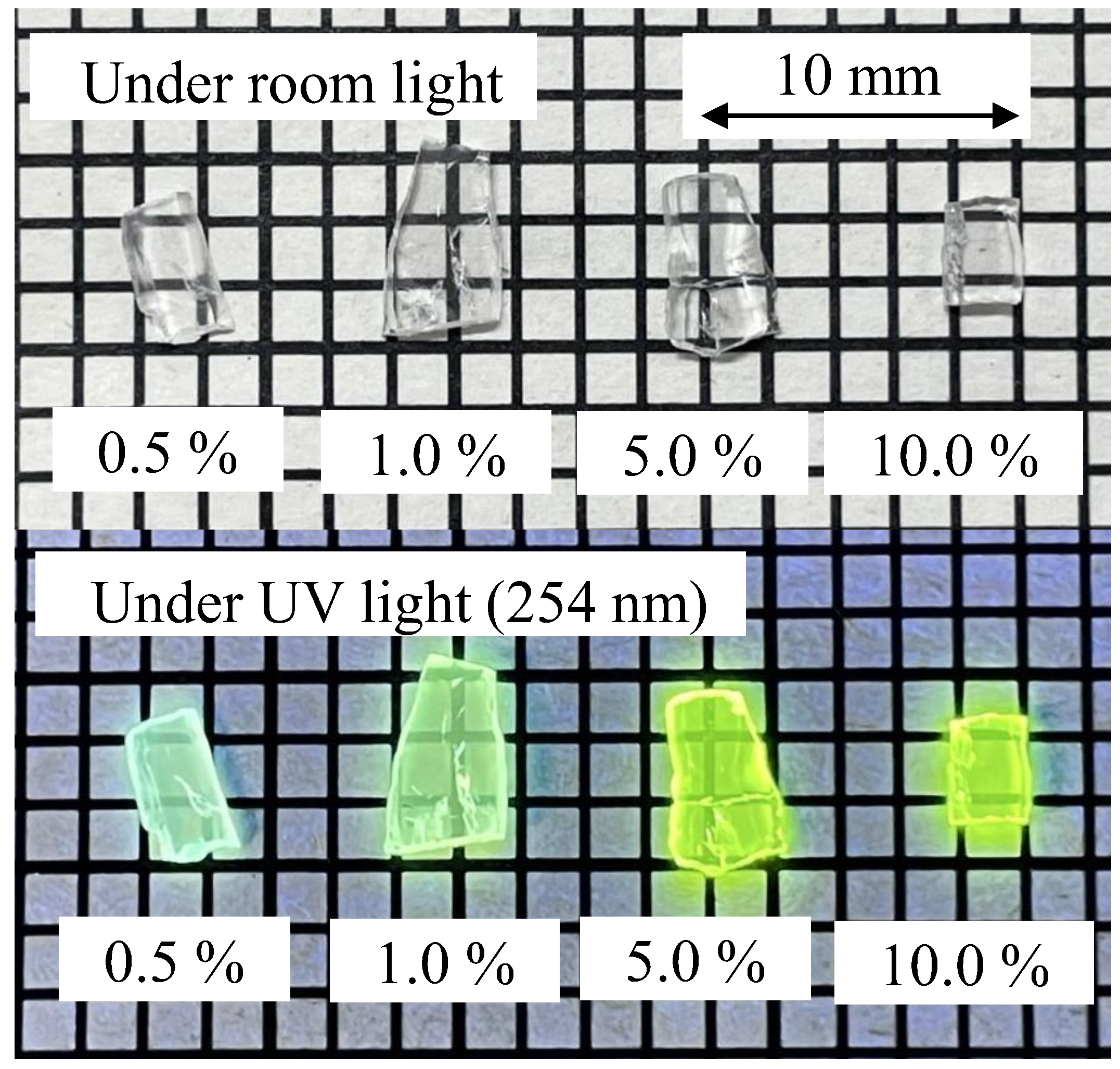

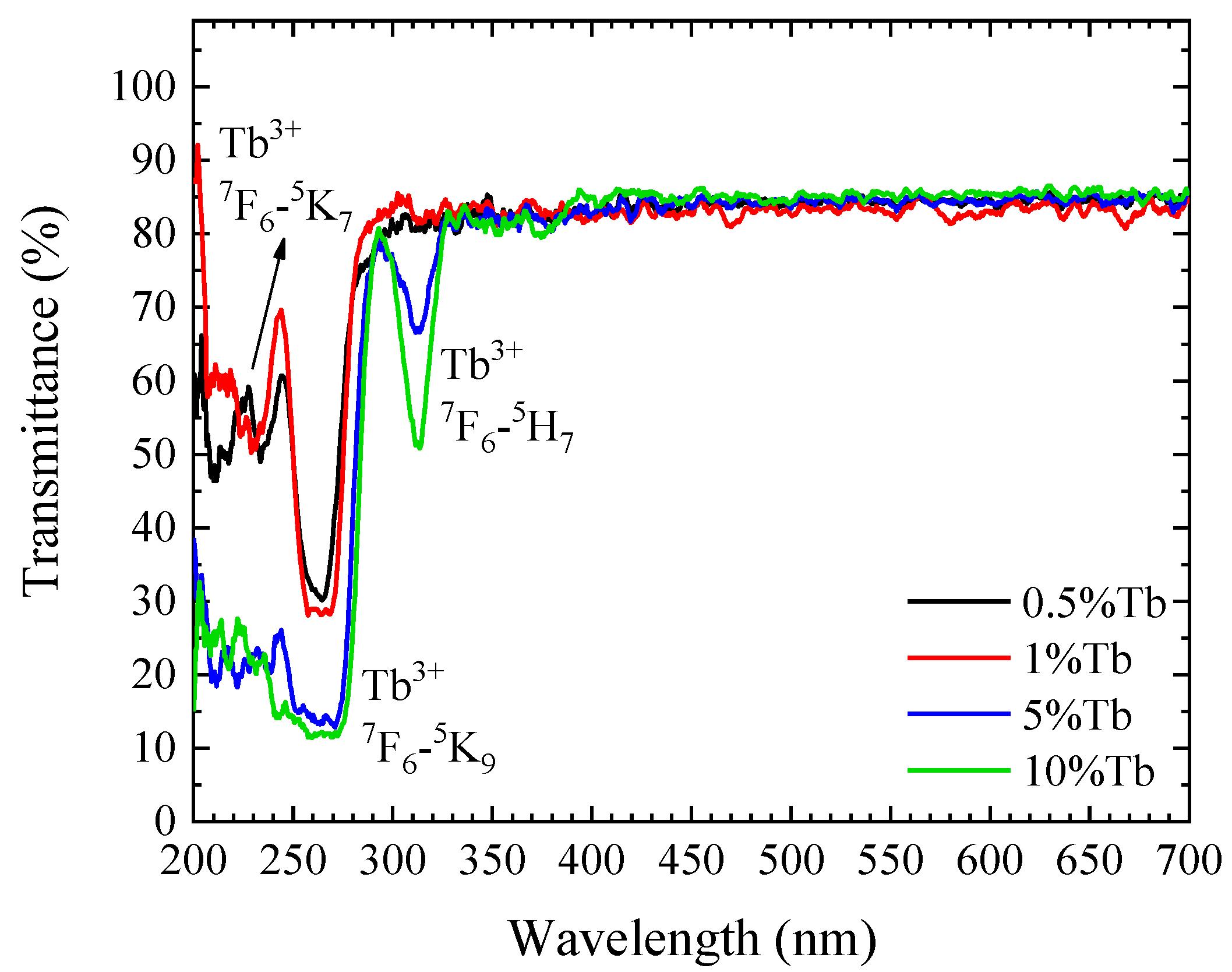
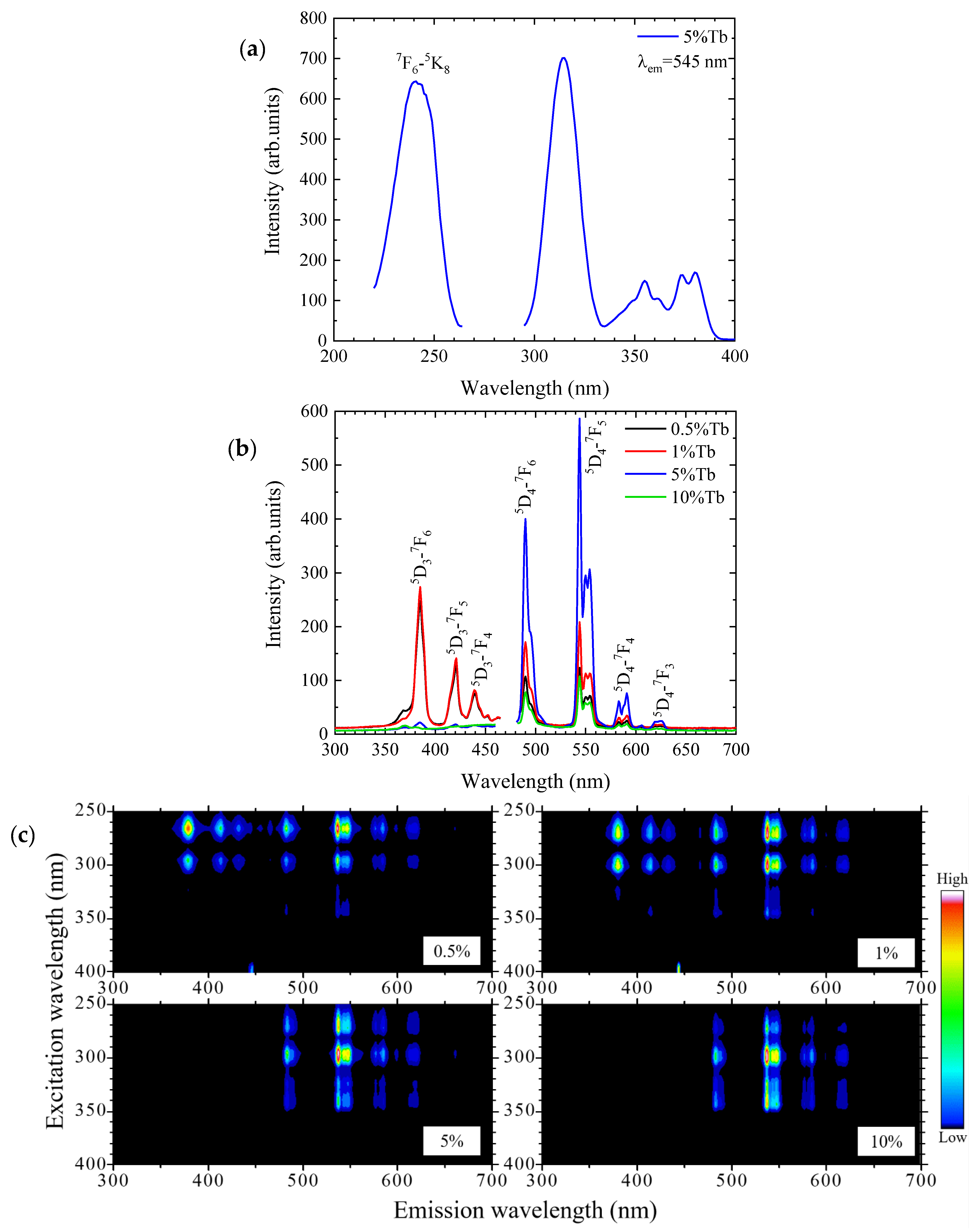
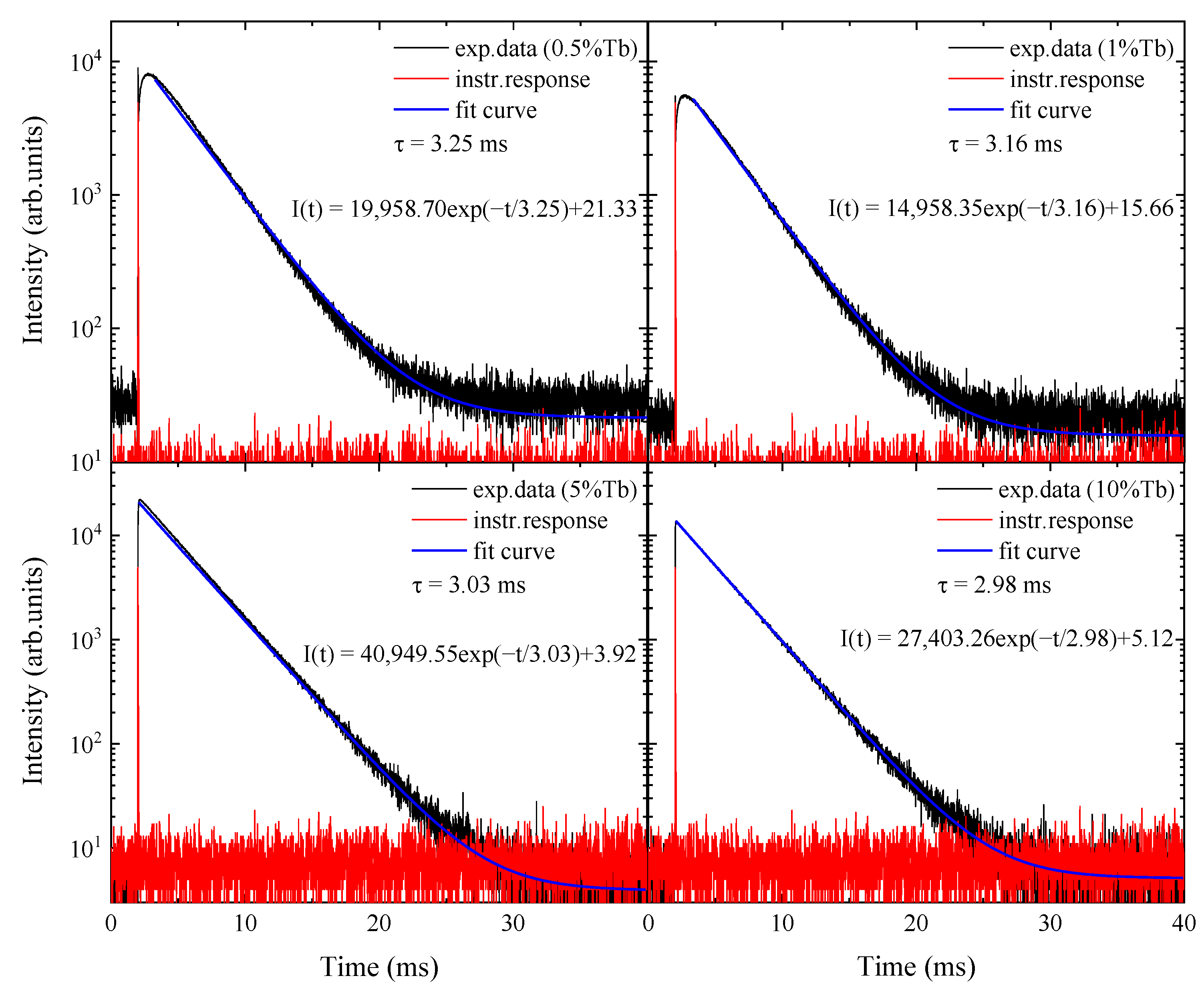

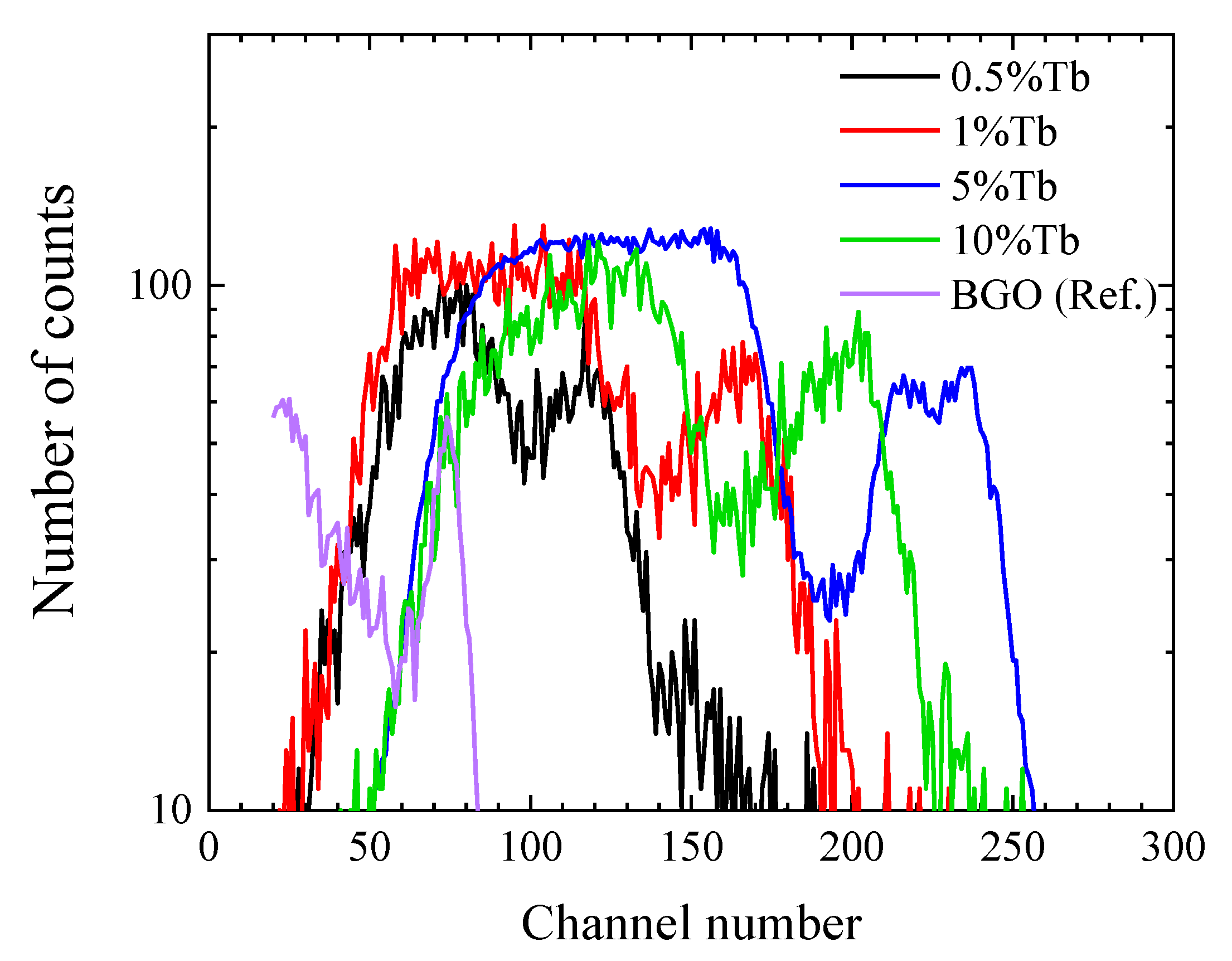
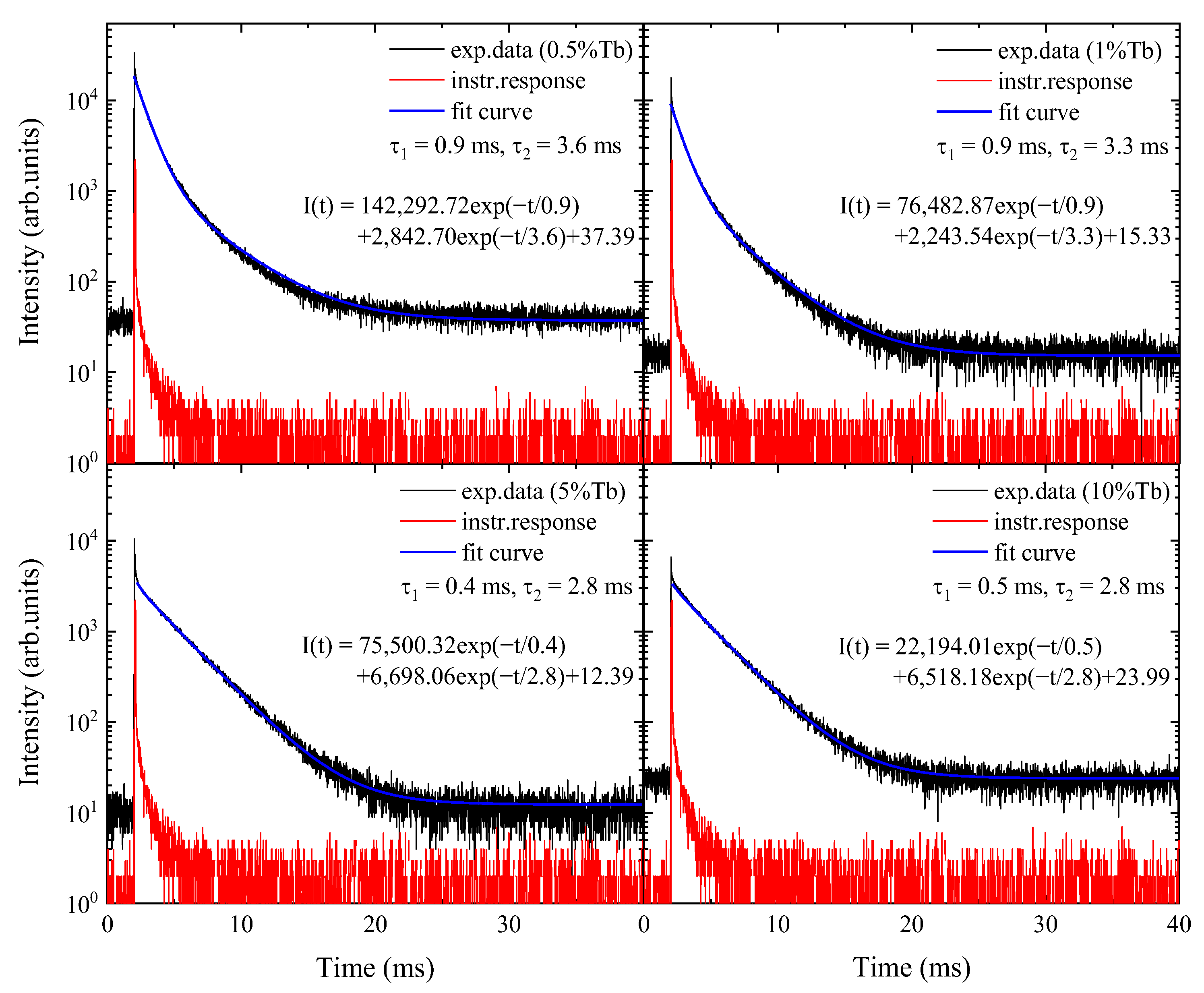
| Samples | τ1 (ms) |
|---|---|
| LuYAGG:Tb 0.5 mol% | 3.25 |
| LuYAGG:Tb 1 mol% | 3.16 |
| LuYAGG:Tb 5 mol% | 3.03 |
| LuYAGG:Tb 10 mol% | 2.98 |
| Sample | LYγ (ph/MeV) | LYγ (% of BGO) | PMT’s Quantum Efficiency (%) |
|---|---|---|---|
| BGO | 8200 | 100 | 24.7 |
| LuYAGG:Tb 0.5 mol% | 30,000 | 366 | 10.7 |
| LuYAGG:Tb 1 mol% | 42,000 | 512 | 10.7 |
| LuYAGG:Tb 5 mol% | 60,000 | 732 | 10.7 |
| LuYAGG:Tb 10 mol% | 50,000 | 610 | 10.7 |
| Samples | τ1 (ms) | τ2 (ms) |
|---|---|---|
| LuYAGG:Tb 0.5 mol% | 0.9 | 3.6 |
| LuYAGG:Tb 1 mol% | 0.9 | 3.3 |
| LuYAGG:Tb 5 mol% | 0.4 | 2.8 |
| LuYAGG:Tb 10 mol% | 0.5 | 2.8 |
Disclaimer/Publisher’s Note: The statements, opinions and data contained in all publications are solely those of the individual author(s) and contributor(s) and not of MDPI and/or the editor(s). MDPI and/or the editor(s) disclaim responsibility for any injury to people or property resulting from any ideas, methods, instructions or products referred to in the content. |
© 2025 by the authors. Licensee MDPI, Basel, Switzerland. This article is an open access article distributed under the terms and conditions of the Creative Commons Attribution (CC BY) license (https://creativecommons.org/licenses/by/4.0/).
Share and Cite
Lertloypanyachai, P.; Kantuptim, P.; Kaewnuam, E.; Kunikata, T.; Endo, Y.; Chewpraditkul, W.; Kato, T.; Nakauchi, D.; Kawaguchi, N.; Watanabe, K.; et al. Tailoring Luminescence and Scintillation Properties of Tb3+-Doped LuYAGG Single Crystals for High-Performance Radiation Detection. Appl. Sci. 2025, 15, 6888. https://doi.org/10.3390/app15126888
Lertloypanyachai P, Kantuptim P, Kaewnuam E, Kunikata T, Endo Y, Chewpraditkul W, Kato T, Nakauchi D, Kawaguchi N, Watanabe K, et al. Tailoring Luminescence and Scintillation Properties of Tb3+-Doped LuYAGG Single Crystals for High-Performance Radiation Detection. Applied Sciences. 2025; 15(12):6888. https://doi.org/10.3390/app15126888
Chicago/Turabian StyleLertloypanyachai, Prapon, Prom Kantuptim, Eakapon Kaewnuam, Toshiaki Kunikata, Yusuke Endo, Weerapong Chewpraditkul, Takumi Kato, Daisuke Nakauchi, Noriaki Kawaguchi, Kenichi Watanabe, and et al. 2025. "Tailoring Luminescence and Scintillation Properties of Tb3+-Doped LuYAGG Single Crystals for High-Performance Radiation Detection" Applied Sciences 15, no. 12: 6888. https://doi.org/10.3390/app15126888
APA StyleLertloypanyachai, P., Kantuptim, P., Kaewnuam, E., Kunikata, T., Endo, Y., Chewpraditkul, W., Kato, T., Nakauchi, D., Kawaguchi, N., Watanabe, K., & Yanagida, T. (2025). Tailoring Luminescence and Scintillation Properties of Tb3+-Doped LuYAGG Single Crystals for High-Performance Radiation Detection. Applied Sciences, 15(12), 6888. https://doi.org/10.3390/app15126888







